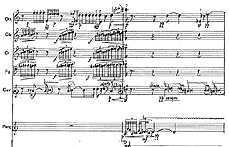Maria
Grazia Bellocchio, pianoforte –Gruppo strumentale dell’Angelicum–
Giampiero Taverna, direttore
Nel
mito greco Arianna, figlia del re Minosse, dà
a Teseo il filo con il quale l’eroe troverà la via per uscire
dal labirinto del Minotauro. Il carattere di questo brano è stato
determinato sotto la suggestione del suo titolo, trasponendo la sua immagine
nella sostanza musicale del lavoro. Una sola figura è l’elemento
cardine della composizione: una sorta di serpente di note in perenne e
tortuoso movimento. Attorno a questo ‘filamentoso’ elemento
ruotano, mescolandosi di continuo, numerose sue varianti e variazioni:
da un lato trilli, tremoli, abbellimenti guizzanti, nuvolette sonore (il
lato dell’indeterminatezza ritmica), dall’altro immagini più
staccate e incisive 8il lato della pulsazione ritmica più marcata).
Ne scaturisce una struttura formale molto omogenea e compatta, quasi monolitica,
che trae animazione discorsiva e maggiore evidenza plastica dall’uso
articolato dei diversi registri strumentali, dall’alternanza di
regioni sonore contrastanti e dai lenti movimenti che la materia musicale
compie spostandosi dal grave all’acuto, e viceversa.
In
Greek legend Ariadne, daughter of king Minos, gave Theseus
the thread by which he found his way out of the Minotaur’s labyrinth.
The character of the entire composition has been determined under the
suggestion of his title, by transposing his image into the musical substance
of the work. Only one figure is the basic element of the movement, a figure
which can be described as a serpentine group of notes in perpetual, tortuous
motion. Around this threadlike element, continuously intermingling, revolve
its numerous variants and variations: on the one side trills, tremolos,
wriggling embellishments, little cluods of sound ( the side of rythmic
indeterminacy), and on the other more staccato, incisive images (the side
of more marked rythmic pulsation). It gives rise to a very omogeneous
and compact formal structure, nearly monolithic, which derives its lively
conversational tone and greater emphasis on flexibility through the distinct
use of different instrumental registers, through the alternation of contrasting
sound areas and through the slow gestures that the musical material effects
in moving from the low to high register and viceversa.
